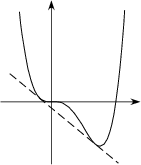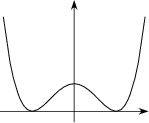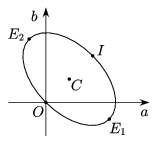 | English Issue, December 2002 | |||
| Previous page | Contents | Next page | ORDER FORM | |
Solutions of problems B
B. 3470. Find the equation of the line that touches the curve y=3x4-4x3 at two different points.
Solution 1. Figure 1 shows the graph of the function f(x)=3x4-4x3. The dotted line is the line whose equation is needed.
Notice that if \(\displaystyle x+\frac{1}{3}\) is substituted* for x in the polynomial, which means shifting the graph by \(\displaystyle {-\frac{1}{3}}\) parallel to the axis, then the resulting fourth-degree polynomial \(\displaystyle f_1(x)= f\left(x+\frac{1}{3}\right)\) contains no cubic term:
\(\displaystyle f_1(x)=3\left(x+\frac{1}{3}\right)^4- 4\left(x+\frac{1}{3}\right)^3=3x^4-2x^2-\frac{8}{9}x- \frac{1}{9}. \)
By forming a perfect square out of the terms of even degree in f1, we get
\(\displaystyle f_1(x)=3\left(x^2-\frac{1}{3}\right)^2-\frac{8}{9}x- \frac{4}{9}. \)
 |  |
| Figure 1 | Figure 2 |
The line that touches the graph of \(\displaystyle y=3\left( x^2-\frac{1}{3}\right)^2\) (Figure 2) is obviously the x-axis, and thus \(\displaystyle y=-\frac{8}{9}x-\frac{4}{9}\) is a double tangent to the graph of f1(x). Hence the solution is obtained by applying the inverse substitution. If \(\displaystyle {x-\frac{1}{3}}\) is substituted for x, the equation of the line will be
\(\displaystyle y=-\frac{8}{9}\left(x-\frac{1}{3}\right)-\frac{4}{9}= -\frac{8}{9}x-\frac{4}{27}. \)
Solution 2. The line y=ax+b touches the graph of the function y=3x4-4x3 at most two points if and only if the graph of the polynomial p(x)= 3x4-4x3-ax-b touches the x-axis at two points, that is, it has two multiple roots. The degree of the curve is four, thus the multiplicity of each multiple root is two, and there are no other roots. If the roots are x1 and x2, p(x) can be factorised as follows:
| (1) | p(x)= 3(x-x1)2 (x-x2)2. |
By carrying out the operations on the right-hand side, we have
3x4-4x3-ax-b=3x4-6(x1+x2)x3+3(x12+4x1x2+x22)x2-6x1x2(x1+x2)x+3x12x22.
As the corresponding coefficients must be equal,
x1+x2 =2/3,
x12+4x1x2+ x22 = 0,
6x1x2(x1+x2) = a,
-3x12x22 = b.
By rearranging (2), we get (x1+x2)2= -2x1x2, and with (1), \(\displaystyle x_1x_2=-\frac{2}{9}\). Then it follows from (3) that \(\displaystyle a=-\frac{8}{9}\), and from (4) that \(\displaystyle b=-\frac{4}{27}\).
Hence the equation of the line can only be \(\displaystyle y=-\frac{8}{9}x- \frac{4}{27}\). This line is really a solution, as the roots of the simultaneous equations (1) and (2) are real numbers \(\displaystyle \bigg(x_1=\frac{1}{3}-\frac{\sqrt{3}}{3}\) and \(\displaystyle x_2=\frac{1}{3}+\frac{\sqrt{3}}{3}\,\bigg)\), and thus all the above steps can be retraced and the factors of the product (1) will be polynomials of real coefficients.
B. A. Rácz, Budapest
<<\setcounter>>equation0 Solution 3. If a is an arbitrary real number, the equation of the line touching the curve at the point (a,f(a)) is y=f'(a)(x-a)+f(a). If b\(\displaystyle \ne\)a then this is identical to the tangent at (b,f(b)) if and only if f'(a)= f'(b)
f(a)- a.f'(a) = f(b)- b.f'(b). From (1), division by a-b\(\displaystyle \ne\)0 yields
| (3) | a2+ab+b2-a-b=0, |
and from (2), in the same way,
| (4) | 9(a+b)(a2+b2)- 8(a2+ab+b2)=0. |
As it follows from (3) that a2+ab+b2=a+b, by substitution into (4) we get
| (5) | \(\displaystyle a^2+b^2=\frac{8}{9}. \) |
Substituting this into (3),
| (6) | \(\displaystyle a+b-ab=\frac{8}{9}. \) |
As the simultaneous equations (5), (6) lead to a fourth-degree equation, let us introduce the new unknowns u=a+b and v=ab. Thus the simultaneous equations are
\(\displaystyle u^2-2v=\frac{8}{9},\qquad u-v=\frac{8}{9}. \)
Substituting \(\displaystyle v=u-\frac{8}{9}\), we get \(\displaystyle u^2-2u+\frac{8}{9}=0\). The roots of this equation are \(\displaystyle u_1={\frac{2}{3}}\) and \(\displaystyle u_2=\frac{4}{3}\). The corresponding values of v are \(\displaystyle v_1=-\frac{2}{9}\) and \(\displaystyle v_2=\frac{4}{9}\).
Now the values of a and b are the solutions of the equations t2-u1t+v1=0 and t2-u2t+v2=0. In the first case, \(\displaystyle a=\frac{1}{3}-\frac{\sqrt{3}}{3}\) and \(\displaystyle b=\frac{1}{3}+ \frac{\sqrt{3}}{3}\), while in the second case the two roots are equal, \(\displaystyle a=b={\frac{2}{3}}\). As a\(\displaystyle \ne\)b, by definition, the second case does not represent a solution.
If \(\displaystyle a=\frac{1}{3}-\frac{\sqrt{3}}{3}\) then \(\displaystyle f'(a)=-\frac{8}{9}\) and \(\displaystyle f(a)-a\cdot f'(a)=-\frac{4}{27}\) thus the equation of the tangent at (a,f(a)) is
\(\displaystyle y=-\frac{8}{9}x-\frac{4}{27}. \)
As all the steps are reversible, the same equation is obtained for the tangent at (b,f(b)).
Remarks. 1. \(\displaystyle a=b=\frac{2}{3}\) is one of the points of inflection of the curve y=4x3-3x2. Strictly speaking, the second case also represents a double tangent but the points of tangency also coincide.

Figure 3
2. The condition (3) \(\displaystyle \left(\frac{f'(a)-f'(b)}{a-b}=0\right)\) obtained in Solution 3 yields an ellipse if a and b are represented on the coordinate axes (Figure 3). This ellipse consists of the points P(a,b) for which the tangents drawn to the curve y=4x3-3x2 at (a,f(a)) and (b,f(b)) are parallel. The axes of the ellipse are parallel to the angle bisectors of the coordinate axes, and its centre is the point \(\displaystyle C\left(\frac{1}{3},\frac{1}{3}\right)\).
The endpoints of the minor axis are O and \(\displaystyle I\left(\frac{2}{3}, \frac{2}{3}\right)\), and \(\displaystyle E_1\left(\frac{1}{3}+ \frac{1}{\sqrt{3}},\frac{1}{3}-\frac{1}{\sqrt{3}}\right)\), \(\displaystyle E_2\left(\frac{1}{3}-\frac{1}{\sqrt{3}},\frac{1}{3}+ \frac{1}{\sqrt{3}}\right)\) represent the points of tangency on the double tangent. This relationship becomes clear if one considers the ``symmetry'' of the fourth-degree curve about the point \(\displaystyle x=\frac{1}{3}\). This is the abscissa of the centre of symmetry in the graph of the third-degree derivative function representing the slopes of the tangents. If the equation of the double tangent is subtracted from the fourth degree polynomial then the resulting fourth-degree curve will indeed be symmetrical about the line \(\displaystyle x=\frac{1}{3}\). (This is a reason for the substitution in Solution 1.) Thus the abscissas of the points of tangency on the double tangent are symmetric about the point \(\displaystyle x=\frac{1}{3}\). The corresponding point of Figure 3 lies on the line \(\displaystyle a+b=\frac{2}{3}\), the major axis of the ellipse.
It is easy to check that all fourth-degree curves with a double tangent have this property, that is, more precisely, \(\displaystyle \frac{f'(a)-f'(b)}{a-b}=0\) will represent a real ellipse in exactly that case. All the ellipses obtained in this way are similar, their eccentricity is \(\displaystyle \frac{\sqrt{3}}{3}\), and they are all obtained as shown in Figure 3. The endpoints of their minor axes represent the points of inflection of the corresponding fourth-degree curves, and the endpoints of their major axes represent the points of tangency on the double tangent.
*This substitution, called the Tschirnhaus substitution, is also used as the first step of solving a general fourth-degree equation. It eliminates the cubic term.
